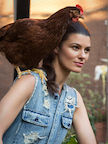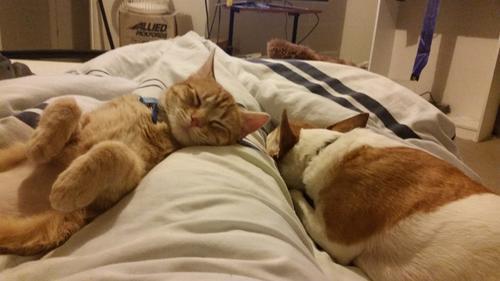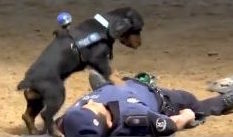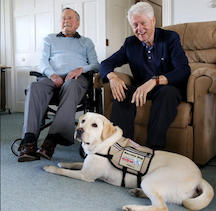Supermodel Chicken
Summer Rayne Oakes & Kippee
 Model Summer Rayne Oakes dispels common stereotypes. A Cornell graduate in Entomology, she has no problems feeding her best friend live meal-worms, something that would make most models squirm. Of course, her best friend is a chicken named Kippee. The two are inseparable and you might see them together on a N.Y. Subway. Kippee has even appeared in several photo shoots.
Model Summer Rayne Oakes dispels common stereotypes. A Cornell graduate in Entomology, she has no problems feeding her best friend live meal-worms, something that would make most models squirm. Of course, her best friend is a chicken named Kippee. The two are inseparable and you might see them together on a N.Y. Subway. Kippee has even appeared in several photo shoots.
Most people have dogs or cats as pets, but Model Summer Rayne Oakes has a chicken as her best friend. But she tells us it didn't start off that way. Summer is a part of a community garden and one day there was a bird caught in one of the inhumane rattraps that were set out by one of the gardeners. She took the bird to a local rehabilitation center in New York called the Wild Bird Fund. While she was at the center, this friendly little chicken just came and jumped on her lap.
Summer had chickens growing up, but never had one fully imprint on her. The chicken at the center was described to her as more of a "people's" chicken than a "chicken's" chicken and Summer believes she must have imprinted on somebody else. Summer ended up fostering the little chicken when she was about three or four weeks old and they have been together ever since. Summer named her Kippicha, which is Dutch for little chicken. But since she's about a year and a half old now and no longer a little chicken, Summer calls her Kippee for short.
Since Kippee goes everywhere with Summer, it is no surprise to see the two of them together riding the subways in New York, which must be a strange sight to most people. Summer believes that most people in the city are so disconnected from farm life, that it is such a surprise. Summer tells us that a lot or people tell her, "Oh, you've just made my day!" Other times when she's traveling with Kippee, she will hear someone whisper, "Oh my God, that was a chicken!" as she's walking away. It is such a delight for people.
Some people Summer runs into raised chickens when they were younger and they have mixed reviews. Some of them had a bad run in with very territorial roosters or their chickens were a little bit more aloof and they couldn't pick them up. Kippee is not like that at all. While she's not so much cuddly, she definitely likes to be petted and be around people. Summer thinks Kippee considers people her flock.
It's a little messy to have a chicken running around your house. Summer says she tried chicken diapers on Kippee when she was young, but said she hates having things on her. Summer has talked to a lot of people who make chicken clothing and they tell her you have to let them suffer through it and they will get used to wearing it. However, she says she can't let her bird suffer through it because she just looks so dejected. When Summer tried a diaper on Kippee, she walked around and then fell over. She also started pecking her feathers out because she was trying to get it off of her. Summer has tried it multiple times and just can't do it.
Kippee refuses to wear things, but Summer thinks that it's also part of each individual chicken's personality. There are some chickens that will just sit on your lap and cuddle with you. Then there are others that are higher strung. There are even some that are more aloof. It really depends on the chicken's personality.
Kippee is a very outgoing chicken and has gone to a number of Summer's photo shoots. Kippee has even been in a number of photo shoots. Kippee has shot everything from like a bidet commercial to Celestial Seasonings Tea. This is all just a byproduct of being around Summer, who has to take Kippee with her everywhere.
 Since Kippee has separation anxiety, Summer has watched a ton of YouTube videos on dog separation anxiety. For chicken separation anxiety, she feels that you just have to deal with it probably slightly differently and yet some of the same ways as well. She talked to a lot of people who had hens that had imprinted on them and one person had said that it took about two years for her hen to separate from her. This worried Summer, as she didn't want to have to carry a chicken around her for another year. She had only left Kippee alone for two hours for the first year.
Since Kippee has separation anxiety, Summer has watched a ton of YouTube videos on dog separation anxiety. For chicken separation anxiety, she feels that you just have to deal with it probably slightly differently and yet some of the same ways as well. She talked to a lot of people who had hens that had imprinted on them and one person had said that it took about two years for her hen to separate from her. This worried Summer, as she didn't want to have to carry a chicken around her for another year. She had only left Kippee alone for two hours for the first year.
Summer wants to be clear that Kippee is not her emotional support hen. However, she does call herself an emotional support human for her. This is because Kippee has detachment issues. Summer is working on that and recently built a new chicken coop for Kippee so she can be around other chickens. In order for her to get her into a coop, Summer actually slept in the coop for two nights just so that Kippee could acclimate and know that it's actually a safe place to sleep. This made all the difference.
Summer explains when you're so connected to an animal, whether it's hen or not, you understand kind of psychologically what they're going through. You want to be able to assuage their pain, anguish or anxiety. So by sacrificing two night's sleep, it made all the difference for Kippee. However, while there are other hens in the coop, Summer calls them "hen-emies." They're not quite Kippee's friends. They're not quite her enemies. They're kind of somewhere in between. Kippee just stays on the periphery away from them when she's not in Summer's house.
Summer thinks this goes to show you that chickens are social creatures. It's part of the reason why they live in flocks. But they do make such great companions. Summer believes that they are definitely much more attentive and connected than cats.
Summer is also an author. Her recent book is called, "How To Make A Plant Love You: Cultivating Your Personal Green Space," which will be available next year. Her last book was on cooking called, "SugarDetoxMe," to help people reduce their sugar intake. Summer is also an environmental scientist and entomologist by training. Now that she lives in the city, away from her country home, she has been able to combat that by bringing plants indoors and currently has around 700 plants in her apartment. As you can imagine, this is a very challenging thing having Kippee indoors, because she likes to mow over quite a few of her plants. Summer has taken some videos of Kippee doing this, and some of her plant friends are like, "Oh my God, be still my heart!" after watching Kippee mowing over these plants. As a result, Summer has a lot of plants with notches out of them. Kippee even destroyed her dieffenbachia, which is something that is typically poisonous to humans, dogs and cats, but for whatever reason it had no effect on Kippee. Since then, Summer has removed a lot of her plants from the floor for fear of Kippee eating them all.
Summer and Kippee don't live alone. Summer has a boyfriend who gets a little bit frustrated with Kippee's egg song. You may be familiar with that song, and it's not necessarily the most beautiful of songs, but Summer thinks it hits at a specific pitch or tone that really irritates him. So she's had to be cautious around the time that Kippee's about to lay an egg. Unfortunately it's not like as if she lays an egg every time at 7:00am or whatever, sometimes it's a little bit later in the day. So it can be unpredictable as to when somebody is home listening to the not so beautiful egg song that chickens have.
Summer is also entomologist, one who studies bugs, something that you don't see a lot of people do, let alone women. She tells us there were about eight people who graduated from her entomology class at Cornell University.
Summer has always loved insects. She has always loved things that were creepy crawly or things that people often overlooked. For a while, she even thought she might want to study mycology, which is the study of fungus. In the end, she studied more ecology, which is the study of biological systems, which encompasses all of that good stuff.
 As far as being an entomologist, she didn't even know if she wanted to take the course at Cornell, but then she took one class with a great guy named Cole Gilbert. He was a tall guy who would always wear Khakis and a Hawaiian shirt. One day the class was walking around Beebe Lake, which is one of the lakes up in Ithaca, with their bug nets. And he was like, "Oh my God, Whirligig beetles!" He then literally hoisted his body into the water, up to his chest, chasing after a beetle with a bubble on its butt. Summer then thought that if anybody gets that passionate about insects after all this time, she's there! This was the class that kind of brought her in and encouraged her to study bugs and not just something that she would do on the side.
As far as being an entomologist, she didn't even know if she wanted to take the course at Cornell, but then she took one class with a great guy named Cole Gilbert. He was a tall guy who would always wear Khakis and a Hawaiian shirt. One day the class was walking around Beebe Lake, which is one of the lakes up in Ithaca, with their bug nets. And he was like, "Oh my God, Whirligig beetles!" He then literally hoisted his body into the water, up to his chest, chasing after a beetle with a bubble on its butt. Summer then thought that if anybody gets that passionate about insects after all this time, she's there! This was the class that kind of brought her in and encouraged her to study bugs and not just something that she would do on the side.
Insects are such a big portion of our environment, so Summer releases a lot of beneficial insects in her house. This is because when you start to get 700 plants, you have to deal with spider mites and thrips and she always tells people some of the best ways to fight pests is actually by bringing in beneficial insects like green lacewings and other bugs.
Summer thinks that people are shocked when they realized that chickens are not vegan and or vegetarian and that one of Kippee's favorite foods are mealworms. She also prefers the live ones versus the dried ones. Summer also thinks this would not only make women squirm, but a lot of her guy friends as well, but not her!
Visit Website
Dealing With Noise Phobias
Dr. E'Lise Christensen, Fear Free
 Some pets can be alarmed or startled by noises like thunder, cars and fireworks. It's not uncommon. Dr. E'Lise Christensen tells us about ways we can desensitize our furry friends. Our pets deserve to be Fear Free Pets.
Some pets can be alarmed or startled by noises like thunder, cars and fireworks. It's not uncommon. Dr. E'Lise Christensen tells us about ways we can desensitize our furry friends. Our pets deserve to be Fear Free Pets.
Dr. E'Lise Christensen is a Board Certified Veterinary Behaviorist. In fact, she is the only Board Certified Veterinary Behaviorist in both Colorado and New York City. She's here to explain noise phobias.
We just got through the 4th of July Fireworks and are currently experiencing afternoon thunder showers in parts of the country, all of which can freak out our pets. The common signs of noise phobias are dogs that are clingy or hiding, panting and they might also whimper and cower.
Noise phobias are a common problem in our pets, both cats and dogs. There are a variety of different noises that animals can be fearful of, but thunderstorms can be one of the most challenging because we can't predict when they're going to happen. It also seems like a lot of these animals predict even faster than we ever could when a storm is going to happen. Sometimes we think they do this potentially through being conditioned to things like bariatric pressure changes, etc.
While it is common, there are lots of great treatments for noise aversions or fears related to specific noises. These include everything from traditional desensitization and counter conditioning, that's done with behavioral therapy by a skilled behavior modification person or a veterinary behaviorist, or you may even be using a medication, especially for noise phobias that are associated with thunderstorms. You just need something to help stop the panic.
For noise phobias, some people use body wraps, which are supposed to swaddle the dog and keep them calm. Dr. Christensen explains that there are some studies on a couple of these different items and it turns out that they can work for some creatures, but they won't necessarily work for every patient. A lot of times we see that the dog might come up to their owners and it looks like they're looking for attention. But when the owner tries to give them attention, it doesn't work and the dog just seems very restless. If a body wrap is not helping relatively quickly, within minutes, and you're not seeing a decrease in the intensity or the frequency of this clinical signs, you need to find an alternative, because every time the patient is exposed and has these symptoms, it's toxic for their brain.
 There are also things a veterinarian behaviorist can do. There is pheromone therapy for dogs and cats. For cats, there are a few different versions that may be helpful depending on other behaviors. For dogs there is a medication that's approved for noise version called SILEO, which can work in around 30 minutes.
There are also things a veterinarian behaviorist can do. There is pheromone therapy for dogs and cats. For cats, there are a few different versions that may be helpful depending on other behaviors. For dogs there is a medication that's approved for noise version called SILEO, which can work in around 30 minutes.
Another thing you can do is desensitization. One of the tricks is making sure that whatever trigger you're using is something that the patient responds to. We know that even for storms, desensitization and counter conditioning, like playing storm sound at a very, very low volume, ideally one that the patient is not responding to at all, can work.
You can start out with a low volume and if you don't see any of that pacing, whining, cowering accesses, scanning, hyper vigilance, any of that stuff, then within one to two seconds after playing it you get food or initiate a game for one or two reps. Then when the patient is comfortable with that level of the trigger, of at least five reps, then you can go ahead and increase the intensity of the sound.
When you're working on that, at the same time the patient may actually be exposed to an actual thunderstorm. That's where using tools and behavior therapy come in handy, like perhaps teaching the animal to go someplace where they feel the safest. Surprisingly, a lot of dogs choose the bathtub. If you know they like the bathtub, you can make it super awesome. You can practice sending them there and give them treats or maybe a food puzzle in the bathtub on a daily basis so that it's not only for storms. Then you could even layer on your desensitization and counter conditioning with that if you wanted to.
 One of the problems with noise phobias, especially with storms, is that if we don't catch them and help these patients feel better; they can get worse over time. They can get worse not just with that trigger, but they can also do what Dr. Christensen calls "collecting triggers." First it's just the rain and the thunder that frightens them. Then it's becoming just flashing lights of any kind or even the sound of sirens. It can happen even when the family tries to close the blinds in preparation for a storm. Basically anything that might be associated with a storm or associated with other noises or light flashes can trigger their phobias. Unfortunately, we can end up in situations where these pups won't even go outside. But with a little patience and the right tools, you can help your animal work through their noise phobias and have a happy, calm and relaxed pet.
One of the problems with noise phobias, especially with storms, is that if we don't catch them and help these patients feel better; they can get worse over time. They can get worse not just with that trigger, but they can also do what Dr. Christensen calls "collecting triggers." First it's just the rain and the thunder that frightens them. Then it's becoming just flashing lights of any kind or even the sound of sirens. It can happen even when the family tries to close the blinds in preparation for a storm. Basically anything that might be associated with a storm or associated with other noises or light flashes can trigger their phobias. Unfortunately, we can end up in situations where these pups won't even go outside. But with a little patience and the right tools, you can help your animal work through their noise phobias and have a happy, calm and relaxed pet.
Visit Fear Free Happy Homes for tips on making your home fear free and to locate a Fear Free Veterinarian near you. Go to Fear Free Pets to become certified.
Listen and Explore the Fear Free Expert Series
Does Your Pet Dream?
Dr. Deirdre Barrett, Harvard Medical School
 Have you seen you pet twitch, move or mumble while they sleep. Could they be dreaming? Harvard Professor and Dream Researcher Dr. Deirdre Barrett shares what she knows about pet dreams.
Have you seen you pet twitch, move or mumble while they sleep. Could they be dreaming? Harvard Professor and Dream Researcher Dr. Deirdre Barrett shares what she knows about pet dreams.
If your pet is a mammal, it dreams. If your pet is a reptile or a fish, it probably does not dream. So what do they dream about? Dr. Barrett tells us that humans dream about the same things that we're most interested in when we're awake. So it's a very strong probability that dogs are dreaming about dog toys, their owners and running around and grassy fields, for the ones that get to do that. They could also be dreaming about the apartment they are in all of the time if they don't go out much. Basically they're dreaming about the things they did by day.
Research has demonstrated that everybody is paralyzed during REM sleep when dreams are happening. But there's a little more data on cats, because researchers destroyed the tiny area in cat brains that inhibits movement during REM sleep. Then during every dream period, the cats would hop up out of sleep, but not awake, and they would stalk around and pounce. It looked like they were chasing mice. So we have even better data that cats dream about chasing and catching mice.
Humans have sad dreams and scary dreams so there's no reason to think that mammals, at least large enough to have similar midbrain areas for the same emotions that we do, are not having similarly sad or scary dreams, according to Dr. Barrett. This might happen in animals that have had serious traumas and they could have post-traumatic nightmares just like humans do.
Two animals to report dreams are Koko, the gorilla who just died, and another gorilla also living with Penny Patterson, named Michael. Koko used to sign fantastic things when she would wake up, about people she hadn't seen in maybe six months or about cars flying through the air, just impossible things. She never did that any other time of day, only upon her awakening. Penny Patterson was quite convinced that these were dream accounts. Michael does have a trauma history. Poachers killed all the gorillas in his group and he was taken as an infant. Penny says that Michael wakes up some mornings, frantically signing, "Bad people kill gorillas, bad people kill gorillas!" Penny thinks that's not only a memory, but that she thinks he's had it as a PTSD (post-traumatic stress disorder) recurring nightmare, just like people who have traumas dream about that trauma over and over.
 We know more about the gorillas, but it's a good guess that similar things apply to cats and dogs. Of course, that's only speculative because Koko and Michael have been the only animals that have even allegedly reported dreams to us. But the cat data of lesioning the area that paralyzes them during dreams and seeing them stalk around and pounce, is also fairly direct evidence of content, according to Dr. Barrett.
We know more about the gorillas, but it's a good guess that similar things apply to cats and dogs. Of course, that's only speculative because Koko and Michael have been the only animals that have even allegedly reported dreams to us. But the cat data of lesioning the area that paralyzes them during dreams and seeing them stalk around and pounce, is also fairly direct evidence of content, according to Dr. Barrett.
Except for the two accounts from the gorillas, the best we can do is generalize off people, that just whoever and whatever is most important to you and anything you're doing, but especially any new skill you're learning, shows up in your dreams a lot. So dogs that are going through dog training are probably dreaming those commands and moves, because people currently studying anything are dreaming about it more than average content.
If you think your pets are having nightmares, there are some things you can do to make them have better dreams. Remember, anything that makes you anxious by day is likely to give you anxiety dreams at night. So really the same things that you'd be doing to keep your dogs and cats comfortable and happy by day, should carry over into their having more happy dreams and fewer anxious or sad ones.
Visit Website
How to Build the Perfect Litter Box - Dr. Debbie
 One sniff upon entering your home and you recognize the unmistakable odor of cat urine and feces. Simba has used your entry hall as his litter box again. But before you lose your temper - stop. By scrutinizing the environment through your cat's eyes, you will likely discover the cause of his toileting mishaps.
One sniff upon entering your home and you recognize the unmistakable odor of cat urine and feces. Simba has used your entry hall as his litter box again. But before you lose your temper - stop. By scrutinizing the environment through your cat's eyes, you will likely discover the cause of his toileting mishaps.
Elimination issues are a main reason for veterinary visits and a primary reason for relinquishment of cats at shelters. House soiling problems can be multi-factorial, with an overlap of behavioral, environmental and medical causes. Feline house soiling can be managed however with sleuth work and patience. The challenge is to think like a cat.
First and foremost, say this and repeat it…"My cat does not eliminate out of the litter box to get even with me." Cats do use urine and fecal scent marks to communicate territory, but this isn't done with spite or in effort to "get even" with you. Inappropriate elimination is a cat's way stating that something isn't right in their world. Understanding this is key before tackling feline house soiling. Focus on what's wrong in Simba's toilet area, not on how the house soiling makes you feel.
Start With a Vet Check
Cat owners often struggle with house soiling mishaps for months or years before enlisting help from their veterinarian. But seeing the veterinarian should be the first step, since health disorders may be at the root of some house soiling issues. Your efforts in restoring litter box usage will be doomed if an underlying medical cause is not addressed at the same time.
Size Does Matter
Make sure your cat's litter box is of adequate size to allow maneuvering. Litter box size should be 1 ½ times the length of cat's body length. Height of the edge also matters. For older kitties, try lower profile litter boxes or plastic under bed storage boxes. An arthritic older cat won't complain or cry in pain with arthritis, she'll just chose to eliminate elsewhere.
Consider the View
Cats don't want to be startled while in the loo. Don't place the litter box in a high traffic area where people and pets are always a-coming and going. Cats prefer a low traffic area where they can have an eye out on things.
Don't place the litter box near appliances which give off noise, vibration and heat, all which disturb your cat while eliminating. Once a negative aversion is created, your cat may not return to use that box in the future.
 Ditch the Litter Box Cover
Ditch the Litter Box Cover
While some nervous kitties prefer the privacy of litter box covers, the majority of cats dislike the tight quarters and limited ventilation litter box covers provide. Consider how you feel in a public porta-potty. Do you like to touch the walls when inside? Sure, people like the way the lid contains odors, but does it really matter how little odor comes from the litter box when your cat is pooping on your oriental rug?
Provide More Than One Box
A common error is assuming that one litter box is all your cat needs. What cat owner loves the litter box, and relishes seeing more of them in the home? But the more the better when it comes to faithful litter box usage, especially with multiple cats. The general rule is to provide one more box than the number of cats. Some cats share litter boxes, others will not. Unless you provide alternate sites you may have elimination issues in multiple cat homes.
Another special consideration is differences in cat's personalities - timid cats may avoid crossing paths with other more assertive pets in home. Be sure to provide litter box sites that won't be blocked by other animal's movements.
If you live in a multilevel home - you must provide litter box sites on each level. This is especially important in multi-cat homes, those with senior cats or those with health conditions.
The Pick of Litters
Litter texture preferences vary and there are many choices from scoopable, clay, crystals, or natural litters. However in one research study of cat's litter box habits, it demonstrated that the majority of cats prefer fine grained scoopable clay based litters that have carbon as their odor absorbing ingredient. Every cat is different though, so try other litter varieties until you find your cat's preference.
Skip the Scents
The verdict is still out on what odors cats prefer, but avoid heavily scented litters or deodorizers if your cat is missing the box. Interestingly enough, one study showed cats preferred cedar and fish odors, while avoiding citrus and floral scents, while another study concluded cats preferred fish or bleach smells to other scents.
Kitty Litter Depth
Ideal litter depth is 2 inches - more isn't always better. Some cats thrive on scratching the bottom of the pan, which is obscured by excessive amounts of litter.
Keep It Clean
Cats are fastidious by nature and will avoid using a soiled or smelly box. The overall cleaning frequency depends on the number of cats in the home. General advice is to scoop twice a day and deep clean the litter pan weekly. Change out clumping litter every 2-3 weeks.
Build It and Kitty Will Use It
By building your cat's dream litter box, your cat will find litter box nirvana. And you'll come to enjoy a better relationship with your kitty family members without those unwanted "presents" in the foyer.
Featured veterinarian known as "Dr. Debbie" on national pet radio program, Animal Radio. Ebook author of "Yorkshire Terriers: How to Be Your Dog's Best Friend"; "Pugs: How to Be Your Dog's Best Friend"; "Mini Schnauzers: How to Be Your Dog's Best Friend"; and "Shih Tzu: How to Be Your Dog's Best Friend." Dr. Debbie's books.
Visit Website
Animal Radio News - Lori Brooks
 "WildBook" For Animals
"WildBook" For Animals
The animal kingdom is getting its very own social network, but instead of vacation pics and baby announcements, it will be filled with data that could help conservationists save species from extinction. It's called WildBook and was built to keep track of wildlife. Researchers can upload images taken from the field. In fact, some of your pictures could already be on WildBook, since the inventors of WildBook comb sites like Flickr and YouTube for pictures and videos that people post from things like whale watching tours and safaris. This allows you to follow the same animals that you saw on your trips, because WildBook will spot the same animal in different pictures that others submit. WildBook also allows researchers to track those animals through their lifetime as well as gain a better idea of population sizes. WildBook works with artificial intelligence-powered pattern recognition software that can tell animals apart. It is similar to the face recognition software on sites like Facebook, which has algorithms that compare points of the face to determine who it's looking at. However, since not all photos being taken of wild animals will prominently showcase a face, WildBook applies its pattern recognition tool to other body parts too. The researchers pick characteristics like the stripes of a zebra, or the ridges on a whale's tail, that commonly show up in images. These are features that are distinct enough from animal to animal for machines to tell apart. This is animal face recognition at its finest and each animal gets its own profile so you can keep track of sightings made by others.
 Police Dog Performs CPR
Police Dog Performs CPR
A new viral video may have sparked a new dog trick idea for others. In it, a police dog in Spain showed off its first-responder skills by performing CPR on an officer who played dead. Poncho, the police canine puppy, was the star of the video, which showed the officer falling to the ground and pretending to be unresponsive. Poncho, wearing a harness with a flashing emergency light attached to it, ran to the rescue, pouncing up and down repeatedly on the officer's chest then alternately putting his ear by the officer's neck to detect whether he was breathing. Poncho continued his heroics on the cop until he stood up and gave the pup a treat.
What Would You Give Up To Take Your Dog To Work?
As part of last month's Take Your Dog to Work Day, Ollie, a human-grade dog food company, polled animal lovers who currently cannot take their dog to the office to see what they would be willing to do to gain that privilege. One in four said they would give up three vacations days if it meant their dog would be allowed in the office. Additionally, 70-percent of pet parents said they would show up to work earlier if it meant they could bring their dog and 68-percent said they would stay later. Two-thirds of those polled said they would be willing to switch to another company if it meant getting pet-friendly perks.
Airlines Want To Ban Support Animals
Two major air carriers, American and Southwest Airlines, are urging the Federal Government to no longer require them to allow Emotional Support Animals (or ESA's) on board. The Transportation Department is reconsidering its rules for traditional service animals and comfort pets. The flight industry group, Airlines for America, which represents American and Southwest, has told the Transportation Department that it should narrow the broad definition of "service animals" to only quote, "trained dogs that perform a task or work for an individual with a disability." That new definition would eliminate federal guarantees for all comfort ESA's, which can now come into the cabin outside of kennels and for no fee. The group is also asking the Department of Transportation to go further and follow the Justice Department in defining "service animals" as only trained service dogs, excluding comfort pets altogether. According to Airlines for America, the Transportation Department's "failure to differentiate between service animals (being those trained to perform a function as well as to behave appropriately in public places) and untrained ESA's have created a huge and growing problem in air transportation, causing threats to the health and safety of flight crews and passengers."
 Former President Gets Service Dog
Former President Gets Service Dog
George H.W. Bush is welcoming a new member of the family, a yellow Labrador retriever named Sully who will be his first service dog. The 94-year-old has been hospitalized several times in the last few years and Sully can open doors, pick up items and summon help. The nation's 41st president currently uses a wheelchair and an electric scooter to get around since developing a form of Parkinson's disease. You can follow Sully on his own Instagram account.
If Your Dog Could Talk - What Would They Say?
Most of us have wondered what our dogs would say if they could talk. Researchers have now published a study in the journal Animal Cognition that translates some of our dogs' most common gestures, 19 of them in all. The body language for "Pet Me" includes these gestures made by a dog: rolling over in front of you; pressing their nose against you or an object; licking you or an object; lifting a paw and placing it on you; gently biting your arm; lifting the back leg while lying on their side; and rubbing their head on you while leaning against you. There are a few gestures that dogs have for saying, "Feed Me," including using their snout and head to move your hand to their body; holding a paw in the air while sitting; standing on their hind legs; and using their mouth to throw a toy forward. Here are a few indicators that it might be time to bring out the toys or "Play With Me": briefly touching you with one paw (kind of how a child taps you to get your attention); diving headfirst under you or an object; and wiggling their body beneath a person or object. And the "I have to Potty" or "Open The Door" body language includes: lifting their front paws off the ground and placing them on you or an object and jumping up and down in the same location.
 Listen to the entire Podcast of this show (#971)
Listen to the entire Podcast of this show (#971)





